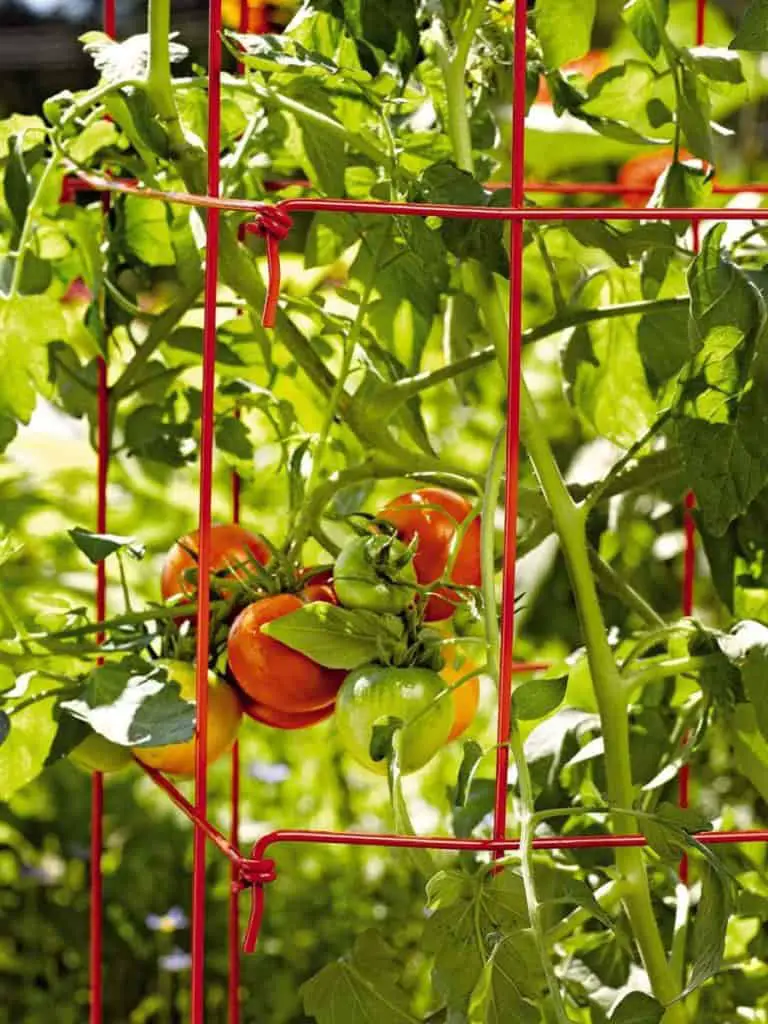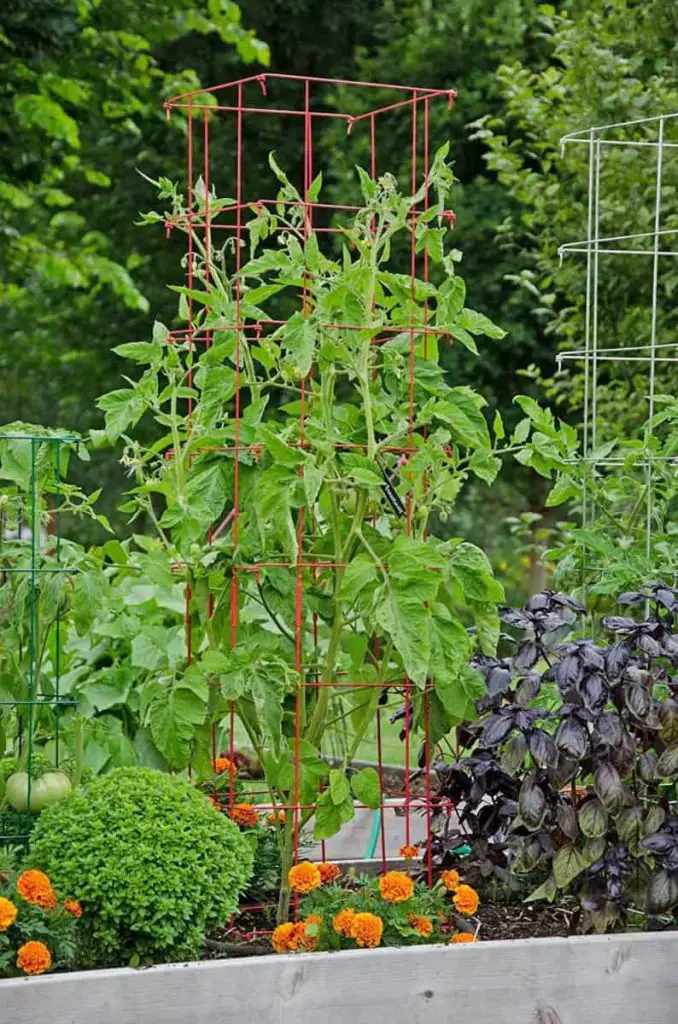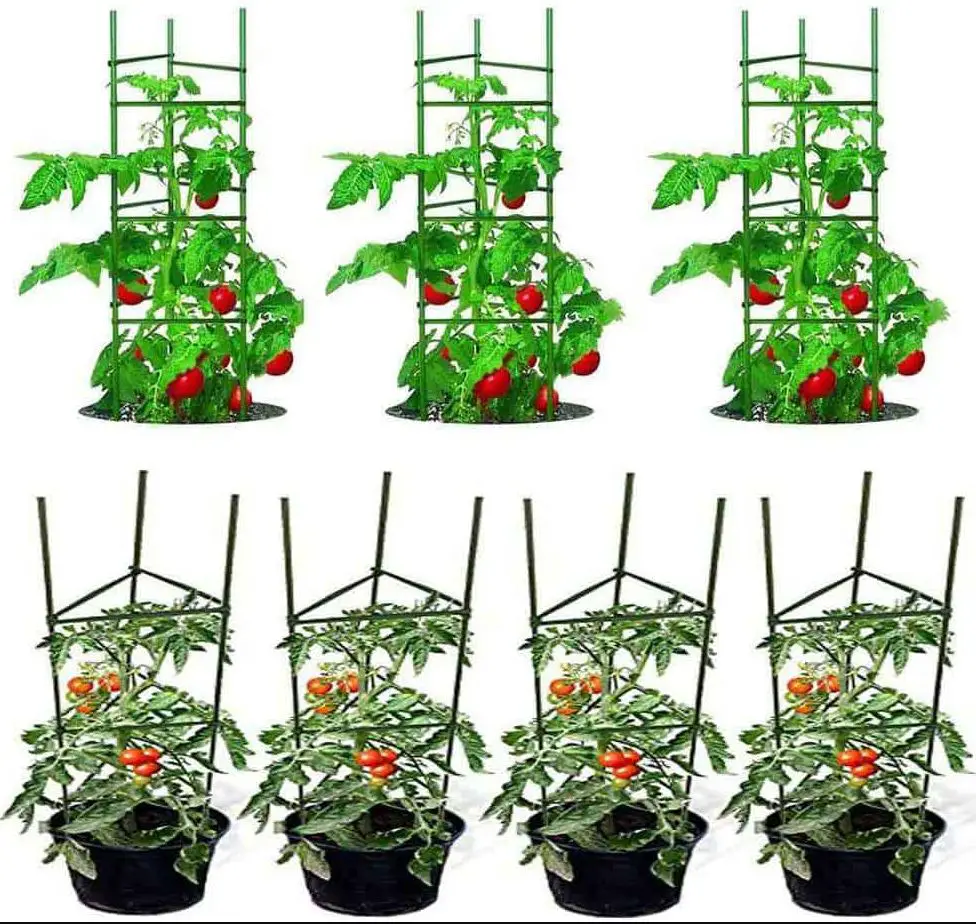Tomato plants without cages are just like a building without pillars. It may fall anytime without support. No matter what type of tomato you choose to grow, a tomato cage is something you must use. They provide the tomatoes with structural support and keep the plant thriving and blooming. When the plants are left to sprawl on the ground, they may be attacked by pests. Tomato cages protect the plants from diseases and various pests.
How to use a tomato cage in a container? To use a tomato cage in a container, you must keep some important points in your mind. For example, shaping the cage legs to the container, securing the tomato cage, properly installing the cage, evenly spacing out the tomato cage, etc. Using tomato cages, while applying these techniques, will help the tomato plant to grow much healthier and safer from diseases.
In recent times, tomato cages have become the most popular choice for growers, especially for home-growers. It provides plants the strength for branches, burdened with fruit, gives plants room to develop, and keeps it unblemished.
What Type of Tomato Actually Needs a Cage?
We often see tomato plants listed as determinate or indeterminate. These terms are used to categorize the plant’s growth. Determinate tomatoes grow too fast up to 3-4 feet in height and then stops growing. Determinate plants need a small cage that helps in supporting the large weight of fruits, ripening at the same time. The type of cage for determinate plants is easily available at the local home and garden centers. Determinate tomatoes harvest easily and are ideal for cooking.
On the other hand, indeterminate tomato plants fruit all season and can grow up to 10 feet in length. Therefore, they need a large cage of about 5-6 feet in height. Few varieties of indeterminate need an extra-large supporting cage. If you are looking for the best tomato cage then you can check our best pick here on amazon.
Using the Tomato Cage Perfectly in a Container
The use of tomato cages has become common these days. But some points must be taken into consideration while using a tomato cage. Applying these methods will not only improve the productivity of your plant but also protects the tomatoes from diseases. So, no need to wait, let’s explore these techniques!
1. Find a Tomato Cage that Fits in your Container
Tomato cages come in a variety of shapes and sizes. Before you choose to own one, you must know which one will best suit your needs. Choose the one that has the same diameter as the container you’ll be using. The minimum height of the cage should be 3 feet. The legs of the cage should be at least as long as the container’s height. If you are using a square container, look for a square tomato cage. These types of cages are difficult to find as compared to round tomato cages. However, they are available at specialty nurseries and stores.
2. Shape the Cage Legs to your Container
The legs of the cage should reach the bottom of the container, enabling the bottom ring of the cage to touch the soil. To fit the shape of the container better, you can also bend the legs of the cage. This gives the cage more support and hence, it will easily support the weight of the growing plant in any direction.

3. Placing cages at a Distance
While using a container, the distance between two pots should be 2 and a half feet. The height of the cage for determinate should be 3-4 feet and for indeterminate,5-6feet height is enough. Keeping available space in mind place containers and water the plants. Carefully insert the wire caging stakes around the young tomato, as the soil is still moist. Make sure the stakes are placed evenly around the plant and center the tomato plant in the cage.
4. Fixing the cage in the soil
Insert some pressure to draw the cages deep in the soil. Some cages are marked and narrow at fixing points like cone-shaped cages. Use the weight of your both hands or a rubber hammer, to firmly press the cage into the soil, at least 6 inches deep in the soil. As the cage holds the weight of the plant, it must not be easy to tip over. Around the base of the tomato cage, firmly compact the soil. For extra stability, you may install stakes along with the cage.
After placing the cage around the tomato plant, carefully support the vines through the cage bars. Without damaging any blooms monitor and adjust the vines continuously.
To tie heavier branches on the cage, use soft twine or a string. Keep monitoring your tomato plant as it grows and lift the vines that may have fallen. Remove the dead leaves and prune the branches that are dead so that the new growth isn’t hindered.
5. Create Your Own Cage
If you are not finding a tomato cage that works for your container or you just don’t want to buy one, no worries at all! You can also make a tomato cage by yourself. They can be made of metal or reinforcing wire, which is easily available at the hardware store.
Start by cutting a piece of wire, having the same diameter as that of the container. Firstly draw the vertical wires deep in the soil and attach horizontal pieces of wires with a knot or weld the joints. Finally, put this cage above the seedling. That’s it! Your tomato cage is ready!
4 Useful Tips for growing tomatoes in containers
Many professional and domestic growers want to raise tomatoes. Containers. However, it is not an easy job. Without knowing certain tips you can’t raise this crop successfully. Let’s check what are these tips!
1. Use Big Containers
This is one of the most important and widely used techniques to ensure tomato success. The bigger the container, the better it is for tomato growth. For one plant, 2 square feet container is ideal. Always use high-quality soil in your container. Make sure to have a good drainage system as well. Most people also grow herbs and other small plants in the container too. However, it’s not necessary.
2. Plant Tomatoes Deeply
Usually, plants are planted rather shallowly, but it’s not the case with tomato plants. Tomato plants are different and need to be planted deeply. This facilitates the underground part of the stem to grow stronger. As healthy roots grow healthy plants. So, always bury the seed deep in the soil and don’t forget to remove dead leaves and branches from the soil line.

3. Water, Water and More Water
This is probably the most important thing to achieving successful tomato growth. Here watering a plant does not mean watering it all the time. It means keeping the soil moist by sprinkling water. However, wet soil is not recommended. So, be careful about the amount of water. Exploding tomatoes is also the result of inconsistent amounts of water.
On a hot summer day, you’ll need to plant your tomato plant twice a day. As plants take up water more efficiently in the morning, you should look to water them at that time. If you don’t want to keep an eye on your tomatoes daily then the self-watering container is the best option.
4. Let the Sun Shine
Always keep containers in a place where sunlight could reach easily.6-plus hours of full sun is a minimum, but 8-plus is better. Check your tomatoes location throughout the growing season and if they are not getting enough sun, move them. In the case of scorching sunlight in summer, tomatoes can stop growing. So, too much heat is not good for delicate plants like tomatoes.
Frequently Asked Questions
Can I Grow Tomatoes in a 5-Gallon Bucket?
Yes, you can grow tomatoes in a 5-gallon bucket. Its procedure is the same as that for tomatoes in a container.
Is it Better to Stake or Cage Tomatoes?
Determinate tomato plants have thick stems and don’t require the need for a cage. However, if you are growing indeterminate plants, tomato cages can be ideal for that.
What Are The Best Tomatoes to Grow in Containers?
The best tomatoes to grow in containers are Bushsteak, Marglobe, Sweet baby girl, Gardener’s delight, or Stupice.
What Causes Tomato Plant Leaves To Curl?
Heat and low moisture cause the edges of tomato leaves to curl and die black. High winds, low humidity, or blowing dust may also be the reason.
How Often Should You Fertilize Potted Tomatoes?
With a general-purpose garden fertilizer, fertilize the tomato plant every two weeks. Water the plant well before applying the fertilizer to prevent root burning.
How To Use a Tomato Cage In a Container: Video Tuts
Conclusion
People often worry and ask about how to use a tomato cage in a container? But hopefully, after going through this article, you won’t face any difficulty in using a tomato cage in a container. These cages can have various benefits for your tomatoes. That’s the reason why their use is consistently increasing.
Whether you are growing tomatoes in your home or a garden, you must be looking to protect them with a tomato cage. This article provides the basic guidelines about the use of tomato cages but still if you have any questions, feel free to ask in the comment section. If you have a hammerhead worms problem in your garden you can check it out.

